We did it! At 7:49 a.m. EDT today New Horizons made history when it zoomed within 7,800 miles of Pluto, the most remote object ever visited in the Solar System. I thought you’d like to see our best view yet of Pluto in this last and sharpest image taken before closest approach. The level of detail is fantastic.
Universe Today’s Ken Kremer is on the scene at mission control, and we’ll have much more news and analysis for you later today. For now, here’s a taste.
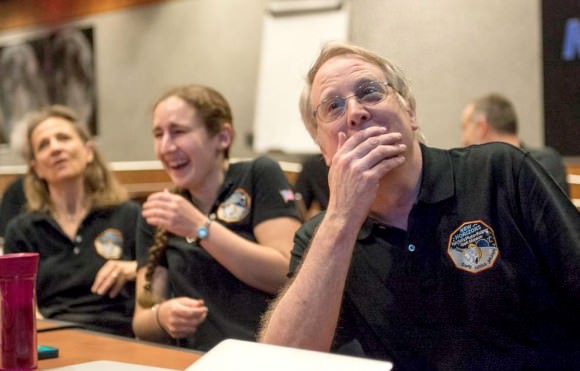
Pluto encounter July 14th 11:00-12:00 UTC (6:00am CDT) by Tom Ruen
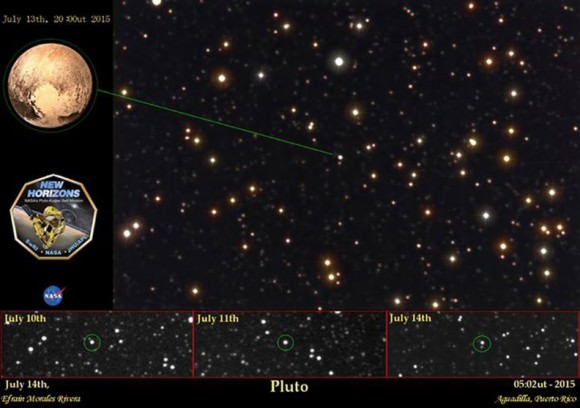
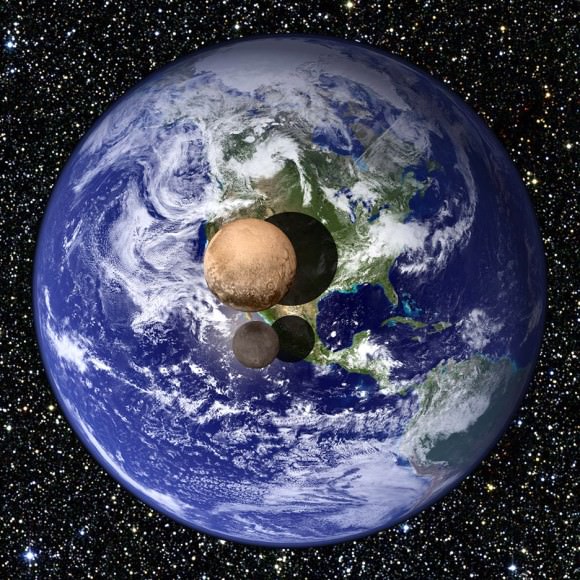
Pluto has a very complex surface. The fact that large areas show few craters – as compared to say, Ceres or Vesta – shows that there have relatively recent changes there. Maybe very recent. Alan Stern, principal investigator for the mission, was asked by a report at this morning’s press conference if it snows on Pluto. His answer: “It sure looks like it.”
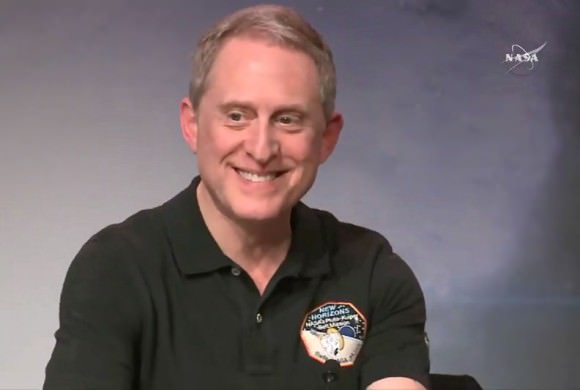
Stern is also confident the spacecraft survived closest approach without getting bulleted by dust. We should know tonight when it “phones home” around 9 p.m. EDT.

Credits: ESA/Rosetta/MPS for OSIRIS Team MPS/UPD/LAM/IAA/SSO/INTA/UPM/DASP/IDA
With the Pluto flyby the latest achievement in over 50 years of humankind’s exploration of the Solar System’s wild assortment of moons, planets and comets, see the bounty of our efforts in this wonderful compendium titled From Pluto to the Sun by Jon Keegan, Chris Canipe and Alberto Cervantes.

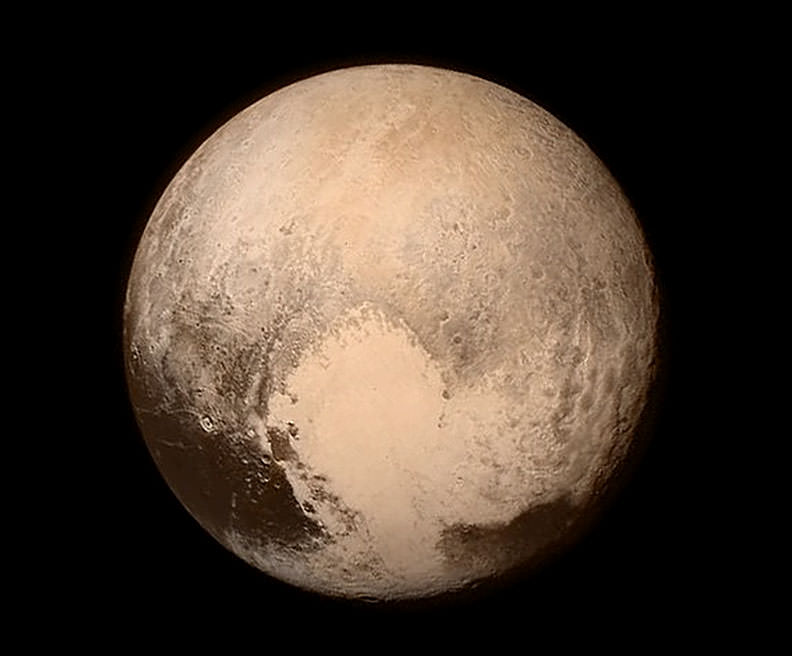
someone spilled her powderbox into that huge crater.
At least, it looks like impacter material rather than Pluto’s
Anyone heard of a sense of speeds of impacts expected at Pluto? That far out in the solar system speeds cannot reach the speeds of the inner solar system unless their speed is based on interstellar motion. Is there a point where impacts change based on that on a crust of ice? That larger crater to the left of the “heart” seems to have some complex relief that to me – purely guessing – looks like a “slow” speed impact frozen in time with a tidal wave stuck in process??
should be low. Pluto’s Orbit speed is 4.7km/s
Compared Earth with its orbital velocity of about 30km/s
Earth impacts are 17 (asteroid) 50 (comets) and upto 70km/s at tangents.
Mostly its angle of approach + acceleration
angle speed of 4.7km/s should be quite low at Pluto’s.
k, then whatever the gravitational attraction of Pluto itself (approx like the escape velocity – ~ 1.2 km/sec)
But clearly we’re talking <10km/sec or approaching that for something orbiting retrograde.
looking further that feature that looked like a frozen tidal wave now to me looks like “snow” on the floor of the crater. It still has a nice raised rim I wonder could be melt that froze in place but it’s less dramatic than I was first seeing.
The dark area does seem to have more craters while the lighter seems to have much fewer craters fiting the idea that the dark areas are tholins long aged by UV.
I wonder if they’ll be able to find generations of impacts approximating the late heavy impact era which would date Pluto to the gas giant migration…
There is also a ridge out from that larger splash crater. It looks like a string of impact craters tightly spaced and arcing. There’s others too perhaps. Such an impact arc – I’m not sure this makes sense for a comet passing, say, near Pluto or Charon, breaking up, and arcing into an impact string on Pluto. There seems to be another string of craters like that far to the left near the horizon that will be more central during closest approach.
The tectonic-like ridge along the edge of the heart shaped area and then north into the middle-region towards the north pole. This would be about opposite Charon so perhaps tidally sourced.
The big white crater “are” actualy multiple impact craters, of which three at least created the ridges you see as “crater arches”.
Wow! Pluto”s name should be changed to “Cupid” what a fantastic picture.. Thanks Bob for the update..
UFOs,
I like that suggestion!
Agreed! Simply beautiful.
Also could be angel or butterfly wings…regardless…these images are as beautiful as confounding. And the best is yet to come!!!
We are geeks in the proverbial “candy store” … we simply cannot get enough astronomy pictures (candy) …..
Good job on the update, Bob …
The look on the Mission Personal is priceless … they cannot even hide their excitement and joy on this … There are going to be a lot of pictures of them with the “OMG!! Look at that…” expressions.
Thanks jjb. More, more, more. Tomorrow and for the next 16 months we’ll be in that candy store.
pretty good sized impact below the equator on the southern limb of Pluto in the middle of the lower white “snow” region (which itself might be a double heart southwards?)
Fantastic. Can only imagine how long it took that little sucker to form. Also so strange to get a glimpse of how small the sun is from there, yet Pluto is still clearly illuminated. Light is an amazing thing.
About the heart region – I wonder if the split on the left side edge represents, perhaps, an echo of the ice age period of the last 248 yr cycle precessed alittle along geographically. I’m guessing a ice age every “year” would leave a pile that might not all melt/sublimate away, and then if there is precession…
Pluto is often compared with (though little smaller than) Triton which has black geysers – I wonder if the dark regions of Pluto could be related….
I would like to see a comparison of measures of activity and cratering patterns of places like Triton, Enceladus, Europa, and Titan. Maybe Ganymede or other similar objects.
See for example http://images.techtimes.com/data/images/full/15480/triton.png?w=600
or
http://www.unmannedspaceflight.com/index.php?act=attach&type=post&id=26431
Hmmm, I’m not an expert, but I think we’ve got a planet in that image there, although some still dispute it. What a wonderful entrance Pluto made. It has almost a fractal pattern with continentally sized bright and dark patches, hexagon craters and covered with a cantaloupe wave pattern. Pluto completely stole the show thus far, we’re still waiting for some images of its chaotic non-circular moons.
Actually I am very disappointed, for a spacecraft to pass within 7,700 miles of Pluto’s surface, I am not impressed in the detail of the photo’s. I would have expected to be able to see much more detail.
scalum76,
You will see much more detailed images with at least 10 times the resolution starting tomorrow when the probe will turn to face Earth and unload all the close up pictures it took during the flyby. This photo was taken yesterday when New Horizons was still some hundreds of thousands of miles away.
Like a good detective story there are many tantalizing clues to fill in Pluto’s history in that top image. The ‘heart shaped’ landscape will soon be revealed for what it is – but in the mean time – My guess or take on this feature is that it is an area of drifting dunes, similar to those seen at Titan. If so, they are probably composed of frozen methane or other organic hydrocarbon grains as icy particles? This feature seems to be spreading northward, up toward the pole in a fan shape(s). Might the material have been scoured from the dark splotches below? Plains swept clean by seasonal wind patterns? The regular rows of lighter splotches stemming from a fractal projection of a hexagon or octagonally shaped southern atmospheric polar feature?
Seasons are weird at Pluto. Because Pluto has an orbital eccentricity of 0.24 the northern summers and autumns last ~80 ‘earth’ years while the winters and springs are ‘only’ ~60 years long. Plenty of time to transport whatever, wherever…
The big beige plain contains a lot of carbon monoxide ice, according to previous spectroscopic studies. But now it appears as though the western and eastern lobes of the “heart” might be significantly different in composition.
Lower left sure looks like a string of pearls and a donut crater.
that image is an instant icon. I almost teared up. my life has changed so much since they launched new horizons. I imagine that this is a very emotional time for some of the support crew.
How appropriate these images reveal an even more distinct love heart… Stern and crew’s 20hr days are getting their overtime paid in images now…
Of course Pluto has a gigantic quadratic crater that spilled over its interior volatiles to the south. Just like everyone expected, or maybe not so much. We’ll see, tomorrow is another day.
Too bad New Horizons couldn’t go into orbit and make long term observations.
Oh come on! “Heart-shaped region”? You mean Pluto-shaped region! Haven’t you seen the picture of Pluto with the Disney dog Pluto superimposed over that region? Come on now, post that picture here!
what a beautiful little dwarf planet! look but don’t touch…you know, because people have a habit of ruining things they lay their hands and/or machines on.
http://i2.photobucket.com/albums/y33/HeadAroundU/the%20dwarf%20and%20the%20king%20of%20dwarfs.jpg
The left lobe of the heart looks like an impact crater while the right lobe and bottom of the heart looks like ice melting and flowing out of the impact region. Possibly a small moon that spiraled in instead of orbiting?
That light Bloch appears to be something leaked out or a big bucket of paint fell there and splattered.